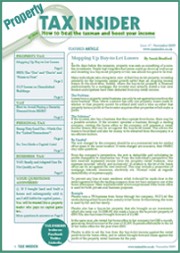Before you go, sign up to our free tax saving email course. Get 7 top property tax saving strategies in your email inbox that will help you save thousands in tax. Unsubscribe any time.
 Structuring property ownership and the taxation of rental income are two of the most common topics which regularly appear on tax forums. Structuring property ownership and the taxation of rental income are two of the most common topics which regularly appear on tax forums.Where a property is rented out, any rental income (less certain deductible expenses) is subject to income tax on the part of the owner of the property. For this purpose, it is the beneficial (not legal) owner(s) who are so liable. Normally, the legal owner(s) will also be the beneficial owner(s), but this is not always the case. In addition, any capital gain arising on sale will be subject to capital gains tax (CGT) on the whole gain; however, if the property has been lived in as the individual’s sole or main residence and also let out during ownership, part of any capital gain will be exempt from CGT and part will be subject to CGT (although lettings relief is also likely to reduce the taxable part of the gain, possibly to nil). Co-ownership Where a property is, or could be, owned by two or more individuals (e.g. a married couple, co-habitees, brother and sister, etc.) mitigation of the above income tax and CGT charges may be achieved by careful splitting of the rental income and the gains. But how can this be achieved? The answer depends upon if the co-ownership of the property is between husband/wife or non-marrieds. Married couples Where the couple is married, if the legal ownership of the property is in the name of both spouses, then for income tax purposes any rental income is automatically split 50:50 irrespective of the underlying beneficial ownership percentages. Thus, for example, where the beneficial ownership is split (say) 60:40, 70:30 or 80:20, the rental income is still split 50:50 but on sale any capital gain is split according to these ownership percentages, i.e. 60:40, 70:30 or 80:20 in the above examples. Legal and beneficial ownership are two different things. Legal ownership is effectively the paper title to the property and will be shown at the Land Registry; beneficial ownership refers to the right of enjoyment of the property (i.e. the right to live in it, or to let it out and receive rental income) and is relevant for tax purposes. The beneficial ownership split is often, but not always, also shown at the Land Registry. Thus, when Mr and Mrs Smith buy a property to let out, they may each be shown on the legal title and may also each have a beneficial interest in the property. Where in such cases Mr Smith is a higher or additional rate taxpayer but Mrs Smith is a basic rate or nil taxpayer, it may be a good idea for Mrs Smith to receive all or the bulk of any rental income to lower the overall income tax charge thereon. This means that it becomes necessary to override the automatic 50:50 income split mentioned above. To do this requires that Form 17 (‘Declaration of beneficial interests in joint property income’) be filed with HMRC. Form 17 allows a married couple to determine how the rental income is to be split; however, any split of such income must be in line with the underlying beneficial ownership percentages. Example – Legal v beneficial ownership Mr and Mrs Smith purchase a property and agree that rental income should be split 5:95 in favour of Mrs Smith; this then requires that beneficial ownership must also be split 5:95. On sale, without further changes, Mr Smith is subject to CGT on 5% of the gain and Mrs Smith is subject to CGT on 95% of the gain. What is not possible is to have a rental income split, say, 70:30 but a beneficial ownership split, say, 80:20 (i.e. a different split). Having completed Form 17, it must be lodged with HMRC within 60 days of its completion to be valid. It must be signed by both husband and wife, one signature being insufficient. It is now also necessary to attach evidence of the beneficial ownership split. Any subsequent change of circumstances subsequent to lodging Form 17 must be immediately notified to HMRC. However, it is important to note that Form 17 is irrelevant where the legal ownership is in the name of one spouse only. In such cases, the automatic 50:50 split does not apply and any beneficial ownership split does not need to be in line with the rental income split. Form 17 is also irrelevant where the co-ownership of the property is by any two or more persons who are not married (e.g. brother sister, co-habitees). The lodgement of Form 17 by a married couple implicitly means that the beneficial ownership of the property is that of ‘tenants in common’ (not ‘joint tenancy’). This has the consequence that, on the death of one spouse, the other spouse does not automatically inherit the deceased’s spouse’s share of the property, in which case a will needs to be drawn up by each spouse to deal with their share of the property. Practical Tip : To avoid the need to file Form 17 a married couple should not be joint legal owners. However, where legal title is held by both spouses, Form 17 need only be filed where rental income is to be split other than 50:50. This is a sample article from the monthly Property Tax Insider magazine. Go here to get your first free issue of Property Tax Insider.
|


 Tax Articles
Tax Articles